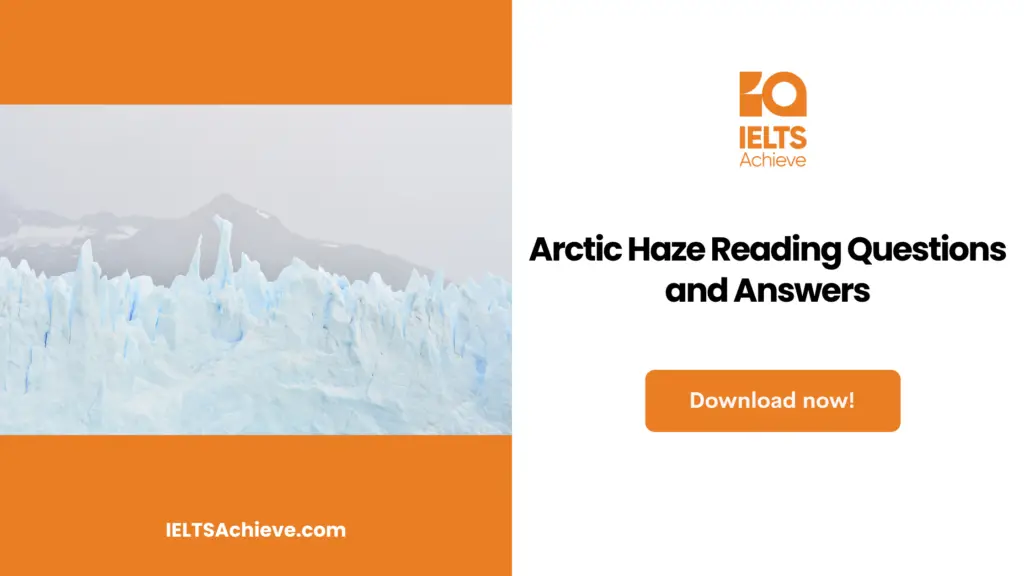The Blog post contains the following IELTS Reading Questions:
- IELTS Reading Summary Completion
Stay informed and prepared for success – Explore our comprehensive Reading Test Info page to get valuable insights, exam format details, and expert tips for mastering the IELTS Reading section.
IELTS Reading passage –Arctic Haze

Arctic Haze
In the 1950’s, pilots traveling on weather reconnaissance flights in the Canadian high Arctic reported seeing bands of haze in the springtime in the Arctic region. It was during this time that the term “Arctic haze” was first used, referring to this smog of unknown origin. But it was not until 1972, that Dr. Glenn Shaw of the Geophysical Institute at the University of Alaska first put forth ideas of the nature and long-range origin of Arctic haze. The idea that the source was long range was very difficult for many to support. Each winter, cold, dense air settles over the Arctic. In the darkness, the Arctic seems to become more and more polluted by a buildup of mid-latitude emissions from fossil fuel combustion, smelting and other industrial processes. By late winter, the Arctic is covered by a layer of this haze the size of the continent of Africa. When the spring light arrives in the Arctic, there is a smog-like haze, which makes the region, at times, looks like pollution over such cities as Los Angeles.
This polluted air is a well-known and well-characterized feature of the late winter Arctic environment. In the North American Arctic, episodes of brown or black snow have been traced to continental storm tracks that deliver gaseous and particulate-associated contaminants from Asian deserts and agricultural areas. It is now known that the contaminants originate largely from Europe and Asia.
Arctic haze has been studied most extensively in Point Barrow, Alaska, across the Canadian Arctic and in Svalbard (Norway). Evidence from ice cores drilled from the ice sheet of Greenland indicates that these haze particles were not always present in the Arctic, but began to appear only in the last century. The Arctic haze particles appear to be similar to smog particles observed in industrial areas farther south, consisting mostly of sulfates mixed with particles of carbon. It is believed the particles are formed when gaseous sulfur dioxide produced by burning sulfur-bearing coal is irradiated by sunlight and oxidized to sulfate, a process catalyzed by trace elements in the air. These sulfate particles or droplets of sulfuric acid quickly capture the carbon particles, which are also floating in the air. Pure sulfate particles or droplets are colourless, so it is believed the darkness of the haze is caused by the mixed-in carbon particles.
The impact of the haze on Arctic ecosystems, as well as the global environment, has not been adequately researched. The pollutants have only been studied in their aerosol form over the Arctic. However, little is known about what eventually happens to them. It is known that they are removed somehow. There is a good degree of likelihood that the contaminants end up in the ocean, likely into the North Atlantic, the Norwegian Sea and possibly the Bering Sea — all three very important fisheries. Currently, the major issue among researchers is to understand the impact of Arctic haze on global climate change. The contaminants absorb sunlight and, in turn, heat up the atmosphere. The global impact of this is currently unknown but the implications are quite powerful.
Unlock your full potential in the IELTS Reading section – Visit our IELTS Reading Practice Question Answer page now!
Recommended Questions:
Renewable Energy IELTS Reading Question with Answer
Questions 22 – 27:
Complete the summary relating to Reading Passage “Arctic Haze” below.Choose your answers from the box below the summary and write them in boxes 22 – 27 on your answer sheet. NB There are more words than spaces, so you will not use them at all.
Example Answer………
that the origins of spring, arctic haze, Theories
first seen over the ice cap…
(eg)__exp._____ that the origins of spring, arctic haze, first seen over the ice cap in the 1950s, came from far away were at first not (22) _______. This haze is a smog formed in the dark, arctic winter by pollution delivered to the Arctic by storms (23) _______ in Europe and Asia. It is known to be a recent phenomenon as proof from (24) _______ shows it only starting to occur in the 20th Century. The smog consists of sulphates and carbon, the latter creating the (25) _______ of the haze. Due to lack of research, the final destination of the pollution is unknown but it probably ends up in the (26) _______ and therefore into the food chain. Scientists are presently more worried about the (27) _______ effect it has on climate change.
| burning terrible ice cores valid certain originating sea destroying theories unknown agriculture decided bird life dissipating accepted gases darkness air density |
Boost your performance in Summary, Notes, Table, and Flowchart Completion tasks. Click here to explore our detailed guide and learn how to effectively complete summaries, notes, tables, and flowcharts in the IELTS Reading section.
Unlock your full potential in the IELTS Reading section – Visit our IELTS Reading Practice Question Answer page now!
Recommended Questions:
Renewable Energy IELTS Reading Question with Answer
Answer:
22. Accepted
23. Originating
24. Ice cores
25. Darkness
26. Sea
27. Unknown

We hope you found this post useful in helping you to study for the IELTS Test. If you have any questions please let us know in the comments below or on the Facebook page.
The best way to keep up to date with posts like this is to like us on Facebook, then follow us on Instagram and Pinterest. If you need help preparing for the IELTS Test, join the IELTS Achieve Academy and see how we can assist you to achieve your desired band score. We offer an essay correction service, mock exams and online courses.

